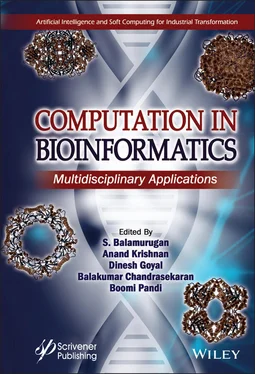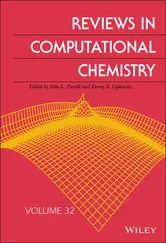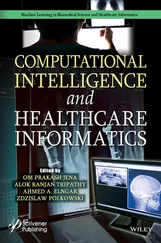Computation in BioInformatics
Здесь есть возможность читать онлайн «Computation in BioInformatics» — ознакомительный отрывок электронной книги совершенно бесплатно, а после прочтения отрывка купить полную версию. В некоторых случаях можно слушать аудио, скачать через торрент в формате fb2 и присутствует краткое содержание. Жанр: unrecognised, на английском языке. Описание произведения, (предисловие) а так же отзывы посетителей доступны на портале библиотеки ЛибКат.
- Название:Computation in BioInformatics
- Автор:
- Жанр:
- Год:неизвестен
- ISBN:нет данных
- Рейтинг книги:4 / 5. Голосов: 1
-
Избранное:Добавить в избранное
- Отзывы:
-
Ваша оценка:
- 80
- 1
- 2
- 3
- 4
- 5
Computation in BioInformatics: краткое содержание, описание и аннотация
Предлагаем к чтению аннотацию, описание, краткое содержание или предисловие (зависит от того, что написал сам автор книги «Computation in BioInformatics»). Если вы не нашли необходимую информацию о книге — напишите в комментариях, мы постараемся отыскать её.
Computation in BioInformatics — читать онлайн ознакомительный отрывок
Ниже представлен текст книги, разбитый по страницам. Система сохранения места последней прочитанной страницы, позволяет с удобством читать онлайн бесплатно книгу «Computation in BioInformatics», без необходимости каждый раз заново искать на чём Вы остановились. Поставьте закладку, и сможете в любой момент перейти на страницу, на которой закончили чтение.
Интервал:
Закладка:
2.3.4 Scoring Function
The scoring capacity is a basic segment in virtual screening. One significant scoring strategy is the information-based scoring technique, which normally removes basic data from tentatively decided protein-ligand edifices and utilizes the Boltzmann law to change the molecule pair inclinations into separation subordinate pairwise possibilities. The capability of mean power (PMF) scoring capacity can change over basic data into free vitality with no information on the coupling affinities and is in this way expected to be progressively material. This strategy verifiably balances many contradicting commitments to authoritative, for example, solvation impacts, conformational entropy, and communication enthalpy. A few wonderful approaches concentrated on these fields are presented beneath.
A kinase family-explicit PMF scoring capacity named kinase-PMF was created with a kinase informational index of 872 edifices from the PDB database to evaluate the authoritative of ATP-focused kinase inhibitors. This scoring capacity acquires the useful structure and iota sort of PMF0443. Contrasted with eight others regularly utilized scoring strategies, kinase-PMF had the most elevated achievement rate in distinguishing positive mixes from fakes as well as gem adaptations. Subsequently, this strategy could enable analysts to screen and upgrade hit mixes in kinase inhibitor improvement.
An improved PMF scoring capacity named KScore, which depends on a few various preparing sets and a recently characterized particle composing plan utilizing 23 re-imagined ligand iota types, 17 protein molecule types, and 28 recently presented iota types for nucleic acids, has been created. In examination with the current PMF possibilities, for example, PMF99 and PMF04, the pairwise possibilities for various particle types utilized in KScore have been fundamentally improved, especially in the field of reflecting exploratory marvels, including the cooperation separations and the qualities of hydrogen holding, electrostatic connections, VDW associations, cation-π communications, and fragrant stacking. KScore is an integral asset for recognizing solid covers from a progression of mixes and can be applied to enormous scale virtual screening. What is more, further upgrades should be conceivable by changing the molecule composing plan and various preparing sets. KScore has been incorporated into the recently referenced atomic docking program GAsDock. Based on the idea and formalism of PMF and a novel emphasis technique, an information-based scoring capacity named IPMF was created. This scoring capacity incorporates extra exploratory restricting partiality data into the information base as reciprocal information to the for the most part utilized auxiliary data.
The utilized emphasis strategy is to remove the 3D basic data and the coupling proclivity data so as to yield an “improved” information-based model. The presentation of IPMF was assessed by scoring a various arrangement of 219 protein-ligand edifices and contrasting the outcomes with seven normally utilized scoring capacities. Accordingly, the IPMF score performs best in the action forecast test. Likewise, when re-positioning restricting postures, IPMF additionally exhibited negligible upgrades over the other assessed information-based scoring capacities. These outcomes recommend that the extra restricting liking data can be utilized for creating scoring capacities as well as for improving their capacity to foresee restricting affinities.
The IPMF approach gives a well-characterized plan to bring restricting data into common factual possibilities, which might be pertinent to other information-based scoring capacities.
2.3.5 Molecular Similarity Methods
As the foundation of structure-movement relationship (SAR) and basic grouping examination, sub-atomic likeness is a significant idea in LBDD. Closeness-based virtual screening and molecular positioning are viewed as one of the most incredible assets in restorative science and have been effectively applied in various cases. Comparability looking through projects can by and large be classified into 2D and 3D similitude as indicated by whether 3D adaptation data is considered. 2D likeness techniques are productive for rapidly profiling neighboring mixes. Be that as it may, it might somewhat give various hits to indistinguishable questions from various 2D likeness definitions target various parts of the data. This strategy likewise will, in general, find close auxiliary analogs rather than novel platform hits. Notwithstanding, 3D comparability techniques ordinarily think about different parts of the 3D adaptation, including pharmacophores, atomic shapes, and sub-atomic fields. 3D strategies can be advantageously used to achieve platform jumping to distinguish novel mixes.
In light of the pharmacophore coordinating methodology, which was utilized as the motor of the recently referenced PharmMapper Server, a strategy named SHAFTS (SHApe-FeaTure Similarity) has been created for quick 3D sub-atomic closeness figuring. This technique embraces crossbreed similitude measurements of sub-atomic shape and hued (or marked) science bunches commented on by pharmacophore highlights for 3D computation and positioning so as to incorporate the quality of both pharmacophore coordinating and volumetric likeness draws near. The triplet hashing technique is utilized to count quick sub-atomic arrangement presents. The cross-breed likeness comprises of shape-density covers and pharmacophore highlight fit qualities and is utilized to score and rank arrangement modes. SHAFTS accomplished unrivaled execution as far as both by and large and beginning time improvements of known actives and chemo-types contrasted with other ligand-based strategies. SHAFTS has been incorporated into ChemMapper Server (unpublished outcome). Spherical harmonic (SH) is a lot of symmetrical round capacities that can without much of a stretch speak to the state of a shut bend surface, for example, a sub-atomic surface. SH extension hypothesis has been effectively applied in virtual screening, protein-ligand acknowledgment, restricting pocket displaying, atomic section closeness, etc. SHeMS is a novel atomic shape comparability correlation technique got from SH extension. In this technique, the SH extension coefficients are weighted to compute closeness, prompting an unmistakable commitment of generally and point by point highlights to the last score. What is more, the reference set for improvement can be designed by the client, which takes into consideration framework explicit and redid correlations. A retrospective VS experiment on the directory of useful decoys (DUD) database and principal component analysis (PCA) reveals that SHeMS provides dramatically improved performance over the original SH (OSH) and ultra-fast shape recognition (USR) methods.
2.3.6 Virtual Library Construction
All over again, de novo drug design tranquilize configuration plans to synthetically fill the coupling destinations of target macromolecules. One of the basic difficulties of this procedure is to choose piece sets that have the best potential to be portions of new medication leads for a given objective. Virtual library development including centered library, directed library, and essential screening library has been proposed as one approach to beat this test. Another test is to set up legitimate criteria for item judgment. To take care of this issue, target similarity and basic assorted variety have been acquainted into library structure with decrease the size and increment the screening proficiency of the built libraries.
Concentrated libraries focus on one specific objective and are based on a lead compound or pharmacophore, while focused on libraries are intended to look for tranquilize leads against explicit targets. Another productive methodology that receives the benefits of both centered and focused on libraries and incorporates advancements from docking-based virtual screening and medication like examination was built up to construct, advance, and survey centered libraries. A product bundle named LD1.0 was effectively created utilizing the new approach. Building squares are chosen from given piece databases to make a progression of virtual libraries. The virtual libraries are then advanced by library-put together GA and assessed with respect to the premise of determined criteria, for example, docking vitality, sub-atomic assorted variety, and medication similarity. GA holds libraries with higher scores and makes new libraries to shape the up and coming age of centered libraries. When the end condition is fulfilled, GA improvement closes.
Читать дальшеИнтервал:
Закладка:
Похожие книги на «Computation in BioInformatics»
Представляем Вашему вниманию похожие книги на «Computation in BioInformatics» списком для выбора. Мы отобрали схожую по названию и смыслу литературу в надежде предоставить читателям больше вариантов отыскать новые, интересные, ещё непрочитанные произведения.
Обсуждение, отзывы о книге «Computation in BioInformatics» и просто собственные мнения читателей. Оставьте ваши комментарии, напишите, что Вы думаете о произведении, его смысле или главных героях. Укажите что конкретно понравилось, а что нет, и почему Вы так считаете.












